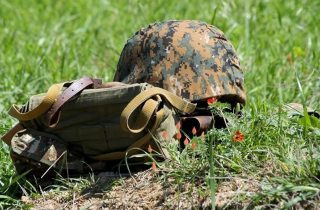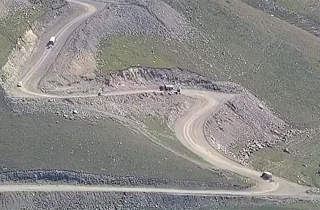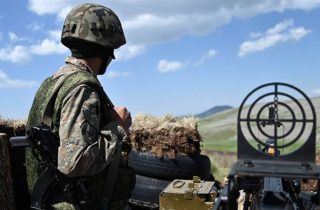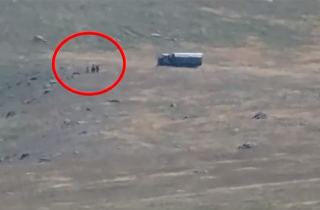
Background Briefing on the Nagorno-Karabakh Conflict

Moderator: All right, guys, well, without further ado, we have two senior State Department officials here to walk you through some of the Nagorno-Karabakh – and that’s several – the Nagorno-Karabakh meetings today, give you a little bit of context on the history and the process behind our negotiations. So without further ado, our first speaker will be [Senior State Department Official One], who is [title withheld].
Senior State Department Official One: Right.
Moderator: What’s your exact title?
Senior State Department Official One: I’m the [title withheld]. Tonight’s meeting will be Secretary Kerry, Foreign Minister Lavrov, and State Secretary for European Affairs Harlem Desir —
Senior State Department Official Two: Of France.
Senior State Department Official One: — of France together with, of course, the two presidents, President Sargsyan and President Aliyev. Just by way of background, this conflict began in 1992. The conflict ran from ’92 to ’94 over the future of this small piece of land called Nagorno-Karabakh. Since ’94 there has been a ceasefire in place. Some call it a frozen conflict but it’s far from frozen. There have been, over the past 20 years, repeated incidents along the so-called line of contact and along the international border between Armenia and Azerbaijan. There are literally dozens of casualties each year, and as you may know, fighting flared up dramatically in early April, April 2 to April 5 – so-called 4-day war – with hundreds of casualties – an estimated 350 casualties including civilians.
Because of that violence at the beginning of April, Secretary Kerry together with Foreign Minister Lavrov and French Foreign Minister Ayrault decided it was time to bring the presidents together again to talk seriously about the peace process. So tonight there are a number of issues that Secretary Kerry hopes to take up with the presidents. The first is the violence that took place early April and continues to take place on a daily basis along the line of contact. We would like to see the parties commit themselves or recommit themselves to the 1994 ceasefire agreement. Both Armenia and Azerbaijan are signatories; both acknowledge that the ceasefire remains in place; and this will be an opportunity tonight to recommit themselves to respecting that ceasefire.
We also believe it’s necessary, given the volatility of the situation along the line of contact, to work towards certain confidence-building measures, and we’d like to see an outcome where the presidents agree to take certain steps that can reduce tensions along the line of contact.
And finally, we want to see a negotiating process underway. We would like to see both sides commit themselves to meeting in order to negotiate a comprehensive settlement of the conflict. Both sides have agreed that the status quo is not sustainable, that there does need to be a process in place and underway that can lead to a settlement. So Secretary Kerry is going to press the presidents to come together in the near future to work towards that comprehensive settlement.
Senior State Department Official Two: Do you want to talk a little bit about the OSCE’s existing footprint and posture?
Senior State Department Official One: Right. Following the ’92 to ’94 war, the OSCE – or then the CSCE – was tasked with negotiating a settlement. They did put in place a monitoring mission which continues up until today. It’s headed by a Polish diplomat with six monitors that operate along the line of contact and along the international border. In the ‘90s, the way the then-CSCE decided to address the conflict was through the Minsk group and in particular through the three co-chairs of the Minsk group who were identified as mediators. So over the past 20 years, there have been opportunities and the sides have come close to agreement, but as you can see, so far they have failed to reach a comprehensive settlement and now is the opportunity.
Question: Can you tell us why in early April did it boil over and become so much worse than it had been for a couple of decades before?
Senior State Department Official: It’s hard to know why and how it started. It’s clear that – it’s been clear over the last year that each side is testing the other’s defenses. One of the most troubling things that’s happened along the line of contact is the introduction of heavy weapons. Even just two years ago, most of the casualties that took place were from snipers – a soldier lifts his head above the trenches and the other side shoots.
Well, over the past year, they have introduced mortars, rocket launchers, artillery, and so each side is testing the other, and clearly, this was a test that led to a much more dramatic conflict, in fact, the worst conflict since the ’94 ceasefire.
Question: When was the last time that the U.S. as co-chair tried something like this as an initiative? I mean, I can go back and remember Colin Powell trying to get things started in Key West, which —
Senior State Department Official One: Right, right.
Question: I can’t remember anything since then.
Senior State Department Official One: Well —
Senior State Department Official Two: Matt had more hair then.
Question: A lot more. (Laughter.)
Senior State Department Official One: Well, that’s not quite true. Secretary Kerry brought the presidents together on the margins of the NATO summit in Wales two years ago. So the presidents – Presidents Sargsyan and Aliyev – have met on a fairly regular basis – several times a year – to try to find a way forward.
Question: But – no, but I mean a U.S. kind of a —
Senior State Department Official One: This – well, the – Secretary Kerry was directly involved and calling the presidents to meet with him in Wales.
Question: Okay. So two years ago is the last time that there was this kind of involvement.
Senior State Department Official One: That’s right, yes.
Question: And then is there anything in particular that you guys would like from the Russians on this?
Senior State Department Official One: Well, this is an issue where we see eye to eye with the Russians. This is what – this is an issue where we have essentially worked through a script where there’s – where we have no differences of opinion. We’re looking at two things, really: reducing the violence, which means respecting the existing ceasefire; and immediate negotiations on a comprehensive settlement. And the Russians share both of those goals.
Question: Are you going to make any proposals that would get into kind of the substance of the conflict?
Senior State Department Official One: Well, we won’t have enough —
Question: (Inaudible.)
Senior State Department Official One: No, we won’t have enough time tonight to work through the proposals, but there are – we call them principles and elements that for —
Question: Sorry, principles and what?
Senior State Department Official One: Principles and elements that are the basis for negotiating a comprehensive settlement. And these elements and principles have been on the table for a long time. So we’d like to have a discussion tonight that – where both sides will reiterate their support for these elements and principles and identify them as the basis for moving forward on a comprehensive settlement.
Question: So there are – I mean, do you believe that there’s an appetite for each other to talk to each other? Because apparently there are some people that think that they’re paying lip service because the Russians told them they had to be here.
Senior State Department Official One: No, I —
Question: There are some that – in those parties that believe that this war is winnable and —
Senior State Department Official One: Well, you will hear that in the region. There are Azerbaijanis who believe that this will – conflict will be settled only through the barrel of a gun. But we don’t believe that either of the presidents supports that. They want to have a negotiated settlement. They’ve come close in the past. They’re not that far apart on what a settlement would look like. So we’ve been trying to bring them together – and tonight is no exception – so that they can narrow those differences. And in this case we’d like to have a sustained negotiating process – a process that can lead to a comprehensive settlement. And by “comprehensive,” we mean it takes all of the issues into account.
Senior State Department Official Two: And the last time they met each other bilaterally was December, right?
Senior State Department Official One: Right. They —
Senior State Department Official Two: And that not a lot a happened then.
Senior State Department Official One: No.
Senior State Department Official Two: But in general, they have okay chemistry with each other. The question is whether, having had this spark of violence in April, they’re ready to actually get back down to it. So that’s what we’re testing tonight, because tonight would at best launch a process.
Senior State Department Official One: What’s remarkable is that they can talk to each other. What we’ve done with them in the past – and I don’t think we’ll have the opportunity tonight; we’re using a different format – is that we’ve allowed them as much time as they want one on one. We put a bottle of scotch on the table and allow them to talk through the issues, and what we’ve learned is they do talk through the issues. They – and they know exactly where – what they need to be talking about. And, as I said, they aren’t that far apart. Now, with a strong push from Secretary Kerry and Foreign Minister Lavrov tonight, we hope that we can find a way into those negotiations.
Senior State Department Official Two: And the French negotiator.
Senior State Department Official One: And the French negotiator.
Question: Two questions. After they talk separately tonight, will they meet together in the same room?
And then secondly, there’s been talk of increasing monitoring along the line of contact. Is there any movement on that issue, and if so, what’s happening with that?
Senior State Department Official Two: The battle rhythm today is Secretary Kerry will meet with each of them separately, and then we’ll do this 3+2 format – the three co-chairs and the two presidents.
Senior State Department Official One: We hadn’t envisioned the two presidents talking with each other separately, but there’s nothing to prevent them from doing so if it makes sense tonight.
Question: What’s the deal with this referendum that the Armenians are threatening? Is that —
Senior State Department Official One: Well, one of the issues that needs to be resolved is – we call it status for Nagorno-Karabakh. And the presidents agree that there needs to be an expression of the will of the population of Nagorno-Karabakh at some time to decide Nagorno-Karabakh’s future. Of course, the Armenians would like a date set and would like to have that referendum done as soon as possible. Our answer to that is that’s not the only issue in play, and when we talk about a comprehensive settlement, we need to talk about all of these elements and principles.
Question: And the recognition, though?
Senior State Department Official One: Well, recognition – there is no country in the world that recognizes —
Question: Yet.
Senior State Department Official One: — the independence of Nagorno-Karabakh, even Armenia.
Question: Right, but I’m just looking at a story that we had from —
Senior State Department Official One: So recognition is not on the table. But what might have caught your attention is a bill that was introduced —
Question: Right.
Senior State Department Official One: — in the Armenian parliament for Armenia to recognize. But that’s – that is coming from an opposition political party and does not have broad support.
Question: Okay.
Senior State Department Official One: Recognition absent a settlement would be seen in Azerbaijan as a declaration of war.
Question: Do you think this meeting will agree on – I know that the Russians have offered peacekeepers and nobody really likes that. Do – can you see some kind of beefed-up monitoring process put in place now?
Senior State Department Official One: Right, we could – one of the things we will talk about is the OSCE monitoring mission and what it could look like in the future. We would like to see a more robust mission, as well as other confidence building measures that could help to reduce the violence. What we’ve said to the sides is, yes, we want negotiations, but these negotiations are not likely to succeed if there – if the conflict has broken out. So we would like to see a period of calm, if that’s possible, where negotiations can take place.
Question: Did the April eruption of violence alter the facts on the ground at all, or did they retire back to the same line of control?
Senior State Department Official Two: No, it did alter facts on the ground. And the Azerbaijanis did take some territory that at least the Azerbaijanis believe is tactically important for them. That – they have not retreated from those positions.
Question: Then they must feel then that gives them a bit of the upper hand. Does that not encourage more violence from (inaudible)?
Senior State Department Official One: Well, you’ll hear different stories from each of the sides. The Azerbaijanis have declared victory, and consider this a significant military victory. Armenians don’t see it that way. They will tell you this is simply hundreds of meters, where Azerbaijan paid a very high price for land that’s not particularly important.
Senior State Department Official Two: They took a huge number of casualties, including comparatively.
Question: You said a few minutes ago you’d like – you were interested in – the U.S. was interested in seeing a more robust monitoring mission. Can you elaborate on exactly ideally what you’d like to see along the line of contact?
Senior State Department Official One: Well, right now there are only six monitors. And that allows monitoring missions to take place two or three times a month. That’s just not sufficient. We’d like to see more monitoring missions in more geographic areas. And if the sides would agree to that, that could be very helpful. One of the problems along the line of contact and international borders is that it’s very difficult to know who initiates the violence. Each side accuses the other. And that was the case on April 2nd. We’d like to have a monitoring mission with the kinds of tools that could identify who – where and when and who is involved when violence breaks out.
Question: But wasn’t Azerbaijan at one point opposed to additional monitoring? And if so, has that issue been resolved?
Senior State Department Official One: They have been opposed to additional monitors. They opposed any confidence-building measures that they believe perpetuates the status quo. That said, we want to take up these confidence-building and humanitarian measures tonight and see if Azerbaijan can agree to some of them.
Senior State Department Official Two: There’s also more you can do with cameras and other kinds of passive monitoring if there was agreement.
Question: Oh, cameras. Careful about that. (Laughter.)
Question: Does the fact that Secretary Kerry’s getting involved in this at a time when, face it, he has not a lot on his plate, suggest you think you’re going to be able to accomplish something significant in, I don’t know, an hour or two of talks?
Senior State Department Official Two: Secretary Kerry’s been interested in this one for a long time. I remember when he first came in as Secretary, one of the first questions he had for me at least was, “Is this one right? If we do more, can we get it going?” We had, as you know, both President Aliyev and President Sargsyan in Washington for the Nuclear Security Summit, which was just before the violence broke out. And he was asking again on whether a little bit of push from him, more personal effort by him might make a difference. So he’s been interested for a long time, and I think particularly after the violence broke out. As co-chairs, it was irresponsible not to try. So that’s where we are.
Senior State Department Official One: It may seem like a very arcane and difficult issue. It’s surprising how much the Secretary really does know about this issue. I was struck when he did host the two presidents at the Wales summit – of course, we had prepared briefing notes for him, but he opened the meeting with his understanding of how the conflict came into – came to pass. And you can imagine with the two presidents sitting there, they were hanging on every word. (Laughter.) And he – it was a remarkably balanced presentation, and I think the presidents were struck at just how well informed he actually is.
Senior State Department Official Two: The other thing is I think he keenly – he is keenly aware it’s a strategic piece of real estate, and particularly with Iran changing its relationship with the outside world, changing with tensions between Russia and Turkey now, the transit opportunities and other economic opportunities if you could settle this thing, but also that the trends, as [Senior State Department Official One] said, have been going in the wrong direction with increased militarization, et cetera. So —
Senior State Department Official One: This is a solvable conflict. There’s some out there that simply have to be managed. This one can be solved, and it takes the political will of the two presidents to reach an agreement. But we concede where the settlement will end up.
Question: Are there any security concerns there involving any terror groups or Islamic State or —
Senior State Department Official Two: There are in – no, Azerbaijan worries about foreign fighters and worries about flows back and forth. They’ve been quite tough and rigorous internally. As you know, we’ve had a long relationship with Azerbaijan watching illicit materials, fissile materials, et cetera. They’ve been a very, very good partner, as has Georgia on those kinds of issues. So there are lots of things here. It’s also, obviously, an economic sink for both countries as they have to maintain militaries, et cetera, at a time when both countries need economic growth. Azerbaijan, one of those countries, suffering quite a bit as a result of low oil prices, looking to diversify its economy. So we want to see them buy less weapons and do more to develop their trade relations in the region.
Senior State Department Official One: This would be a win-win for both sides. Azerbaijan’s overwhelming objective is to get control of the land surrounding Nagorno-Karabakh, and that’s very possible as part of a comprehensive settlement. For Armenia, the issue is status. And they can get this status also as a part of a comprehensive settlement. So it’s possible, if the presidents have the will to walk out and to tell their people that they have – they have won what has been lost over the last 20 years.
Question: So by the end of today, when you say you want to stop the violence, you want some agreement, you want them to give their word that they’re going to stop, or —
Senior State Department Official Two: So let’s see how it goes tonight. Maybe there’ll be some sort of a statement; maybe they’ll just be parallel public statements; maybe it’ll be the first meeting with some requirement for follow-on. Let us – let’s see how it goes. Okay?
Question: Okay, so it’s —
Senior State Department Official Two: But again, remember that since the violence broke out in April, this is the first time that two guys have sat down together.
Senior State Department Official One: Right.
Question: Yeah.
Senior State Department Official Two: And it takes usually international midwifing to get that to happen. So this is the first effort.
Senior State Department Official One: Right.
Senior State Department Official Two: All right? I think we’ve done it, right?
Moderator: Folks, I think we’ve done it.
Senior State Department Official Two: Yeah.
Moderator: Thanks so much. That was really fantastic.
Question: Yeah, very interesting.
Moderator: Well done.
Senior State Department Official Two: Yeah. And this is a little map for you guys, and we will —
Moderator: And maps included.
Senior State Department Official Two: Yeah. If there’s anything to report on (inaudible), we will do that.
Moderator: Just a simple – right. Absolutely. And just a simple reminder this is on background, Senior State Department Officials One and Two. Thanks.
U.S.Department of State























